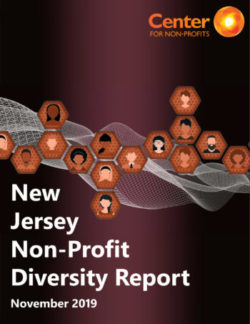Nov
21
2019
Written by Catherine Foley
The Center for Non-Profits just released the 2019 New Jersey Non-Profit Diversity Report, which is based on their 2018 NJ Non-Profit Compensation and Diversity Survey. While the report applies to one specific state, its findings reflect what is taking place on a larger scale in the nonprofit world, particularly the lack of diversity and equity in executive leadership and the apparent disconnect between nonprofit management and the communities they intend to serve.
I was particularly interested in this report since I was born and raised in New Jersey. Growing up in my hometown, you could walk 4 miles from the majority white north end, with its mini-mansions and pristine parks and old-timey shops, to the majority black and brown south end, which just lost its only grocery store to a real estate company that is now promising to build luxury apartments in its place. My hometown is a microcosm of the broader New Jersey population. It is definitely majority white, but it is becoming more diverse (if you’re just looking at the numbers) and that is how it is marketed to the outside world. However, the truth is as troubling as it is deeply frustrating. New Jersey has one of the most diverse populations in terms of race and ethnicity, yet it is also one of the most segregated states in the country and maintains a staggering racial wealth gap.
The 2019 New Jersey Nonprofit findings on racial/ethnic diversity and staff leadership, found that 67% of the groups serving primarily communities of color had white CEOs and 33% had CEOs of color. Only 10% of CEOs of color led organizations that do not primarily serve communities of color. This supports the findings that leaders of color are especially underrepresented in nonprofits that don’t primarily serve communities of color, reported in the BMP’s ED/CEO Race to Lead brief. At the same time, whites are more likely to lead in organizations that serve communities of color and those that don’t. Furthermore, data from our Race to Lead survey shows that POC-led organizations tend to have smaller budgets and that EDs/CEOs of color report a lack of funding relationships as a reason for stress and eventual burnout (a fact which Vu Le, ED of Rainier Valley Corps, warns about in this recent blog post). The Center’s report makes clear that people of color are underrepresented on boards and in staff leadership positions. Organizations with greater diversity in their board, executive, and staff are still seriously underfunded compared to those with little diversity. If the sector wants to support the leadership of people of color, that means supporting the organizations POC are currently leading, rather than only providing resources for white-dominant groups that are interested in diversity.
It is easy for me to imagine the dissonance between NJ nonprofit boards and staff and their constituencies in terms of diversity and race equity. What I’ve come to notice, particularly in my hometown, is a very intentional blindness when it comes to addressing the “equity” and “inclusion” part of DEI. “Diversity” just seems to be enough for some people. I was happy that The Center was willing to call out and document issues that have burdened NJ for years. As a new member of the BMP staff, I also observed how the findings reflect and bolster BMP’s own learnings from the Race to Lead Initiative. As the report states, “it’s important to avoid masking or side-stepping the harsh realities and hard discussions about racism and the intersectionality of race and other forms of discrimination and bias” (4).
The Center’s new report also adds important insights about issues of board diversity and community representation. According to their data, the surveyed organizations reported that 79% of their board members were white, a figure that is consistent with national studies on the racial diversity of nonprofit boards. Equally as important is the fact that even though 69% of white respondents reported they primarily serve communities of color, nearly half (47%) of the respondents said that their organization’s bylaws did not address the issue of diversity on their boards.
There is also promising news! Forty-three percent of the respondents reported having a values statement about the importance of diversity on their boards, a first step towards creating a diverse, representative board. Unfortunately, only 2% of the survey respondents reported that their orgs were required to have a number or percentage of their board represented by the target population. If organizations commit to implement bylaws that directly address the issue of diversity, it could become a standard action step that capacity builders can use in other organizations. In addition, organizations can better represent their communities by creating opportunities for constituents to actually serve on the board, a strategy which BMP Senior Research Analyst Ofronama Biu writes about in this blog post. This report shows there is still much to be done in NJ and in the nonprofit sector at large. Organizations are at different stages of developing their DEI efforts – some have not yet begun in earnest, others have expressed an interest or a desire to do so, and a few more have taken actionable steps to create diverse, equitable, and inclusive environments (see Equity in the Center’s Awake to Woke to Work tool). What is clear is that a “diverse” population does not address the gaps in racial, ethnic, and gender equity. It remains the duty of the nonprofits who serve those communities to address such gaps and to accurately represent constituents and their needs.

